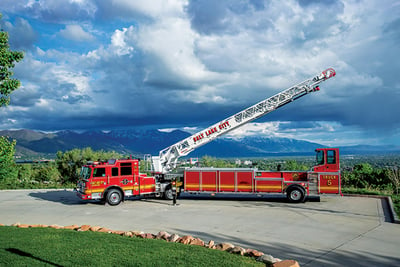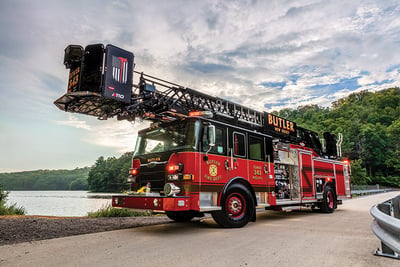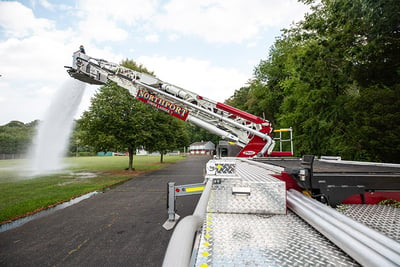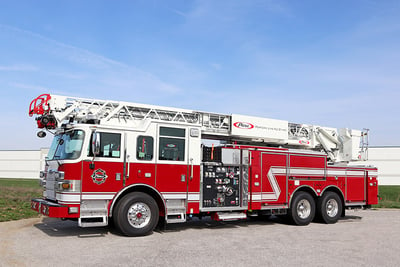
When a fire department is in need of elevated firefighting and rescue capabilities, it may consider an aerial fire truck.
But there is one critical component to consider: does the department require a water pump and tank on the apparatus?
This blog will compare aerial apparatus with a pump and tank versus an aerial apparatus with no pump and no tank to help fire departments understand the capabilities of each.
Aerial with No Pump and No Tank
 An aerial apparatus with no pump and no tank is a very traditional type of emergency vehicle common to the Northeast and East Coast regions. Traditionally referred to as a ‘truck company,’ a no pump, no tank aerial has a large complement of ground ladders.
An aerial apparatus with no pump and no tank is a very traditional type of emergency vehicle common to the Northeast and East Coast regions. Traditionally referred to as a ‘truck company,’ a no pump, no tank aerial has a large complement of ground ladders.
The National Fire Protection Association (NFPA) typically classifies an aerial with no pump and no tank as an “Aerial Fire Apparatus” as outlined in Chapter 8: Aerial Fire Apparatus, stating, “The apparatus shall be equipped with an aerial ladder, elevating platform, or water tower that meets the requirements of Chapter 19 (Aerial Devices).”
A fire department may be interested in a no pump no tank aerial based on several key factors:
- Tight areas where the apparatus and aerial device cannot reach. In historical communities and congested urban areas, fire trucks and even aerial devices cannot access certain areas. In these cases, a truck with aerial rescue capabilities and a large number of ground ladders is essential. Ground ladders are critical in firefighting operations and a truck with a large complement of ladders is a great addition to an existing fleet of vehicles.
- High storage requirements. If a fire department finds itself in need of both an aerial device and high storage capabilities, it may choose a no pump, no tank apparatus.
- Fleet requirements. Each department fleet is different and may require specific types of trucks to support the vehicles already in service. This is often true when other vehicles in the fleet carry water, like a dedicated water tanker or pumper truck.
Aerial With A Pump and Tank
 According to NFPA standards, an aerial apparatus with a pump or tank must include a water tank that holds at least 300 gallons of water.
According to NFPA standards, an aerial apparatus with a pump or tank must include a water tank that holds at least 300 gallons of water.
Most of the time, an aerial with a pump and tank is a quint, so-called because it carries five essential firefighting assets:
- Hose (minimum 800 feet of at least 2-½ inch diameter and 400 feet of at least 1-½ inch diameter)
- At least 300 gallons of water
- Pump with a minimum capacity of 1,000 gallons per minute
- Aerial device with a permanent waterway
- At least 85 feet of ground ladders
A fire department may choose an aerial fire truck with a pump and tank, or a quint for several reasons.
- Emergency response procedures. Many departments have established operating and firefighting procedures where an aerial apparatus with a pump and tank is required.
- Versatility in fireground response. Many departments use quint fire trucks because of their versatility in the field.
- An aerial with a pump and tank is a cost-effective choice. Choosing an aerial apparatus with a pump and tank means it can function effectively as an initial attack vehicle and as an aerial support vehicle, making it like two trucks in one.
How Do Fire Departments Choose Between Aerial Options?
 When it comes to selecting and designing an aerial apparatus, there are many factors that go into making the best choice for your fire department.
When it comes to selecting and designing an aerial apparatus, there are many factors that go into making the best choice for your fire department.
It is often advisable to start by evaluating your department and asking these simple questions:
- What are the needs of the department? The type of aerial apparatus you choose should be based on the needs of your department. What call types will the apparatus support and what unique attributes must the truck have to manage emergency response efficiently? Fire trucks are a long-term investment—think about your department’s needs now, but also how they might change in the future as your community grows and changes.
- What fire apparatus types are already in the fleet? No department has the budget (or the space) for equipment that isn’t needed. Evaluate your current fleet to determine any shortcomings: do you already have adequate water supply in your vehicles and just need an aerial device, or will a new apparatus with water better meet your needs?
- How does the department respond to the scene? In many circumstances, evaluating the department’s response strategy can help advise on the type of aerial apparatus to select. For example, if the goal is to have an initial attack vehicle, then choosing an aerial apparatus with a pump and tank to initiate fire suppression efforts immediately may be best. Conversely, if a department always sends a pumper or tanker to the scene, an aerial apparatus with no pump and no tank may be the right fit.
- What amount of hose and water do you require? Based on historical calls and typical emergency response, fire departments can get a good sense of the mission of the truck and the amount of hose and water required to be effective in the field.
How Pierce Manufacturing Supports Fire Departments
 Choosing a fire truck to add to your department fleet is a difficult task. The physical and performance attributes of any new aerial apparatus will transform your operations and enhance your emergency preparedness and response.
Choosing a fire truck to add to your department fleet is a difficult task. The physical and performance attributes of any new aerial apparatus will transform your operations and enhance your emergency preparedness and response.
Pierce Manufacturing provides the support and guidance you may need as you start your firetruck procurement process.
- The step-by-step fire apparatus design guide helps lay out the entire process and provides easy-to-follow information.
- The blog, ‘The Order Lifecycle of a Fire Truck’, offers guidance on the fire truck bidding and ordering process and is designed to help fire department representatives navigate the required process steps.
- Lastly, the purchasing consortium guide provides an overview of the streamlined consortium process, which satisfies the bidding process and gets right to the buying process.
From the initial consultation to product support through the lifetime of your apparatus purchase, Pierce and its network of trusted dealers is ready to help you on your aerial apparatus journey.
Which aerial apparatus do you prefer and why? Tell us your thoughts in the comments below.

